Saved by a Whale
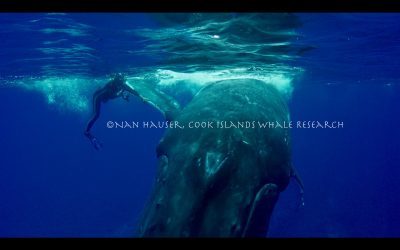 Nan Hauser has spent much of her adult life raising her family in Brunswick and in the South Pacific Cook Islands. Many locals know of the charismatic nurse-turned-whale biologist who spent the better part of three decades studying humpback whales in Rarotonga, her research base. The readers of The Cryer were first introduced to Hauser’s lifelong passion in February 2009, when we reported on her research about humpback whales when she gave a standing-room-only presentation at Curtis Memorial Library in Brunswick, sponsored by Cornerstones for Science. Hauser had a close encounter with a humpback whale on September 14, 2017 in the waters off of Rarotonga. She was saved from a 15-foot tiger shark attack. On September 29, 2018, the whale came back again. In all her years of research, this has only happened two other times. As a child, Hauser and her family spent time in Bermuda. Nan remembers looking out into the vast Atlantic Ocean and dreaming about whales. “That is when I think my passion for the ocean and studying whales really began,” the 64 year-old recalls. Her brother Ted Daeschler shares the same fascination and is a world-renowned archaeologist and explorer.
Nan Hauser has spent much of her adult life raising her family in Brunswick and in the South Pacific Cook Islands. Many locals know of the charismatic nurse-turned-whale biologist who spent the better part of three decades studying humpback whales in Rarotonga, her research base. The readers of The Cryer were first introduced to Hauser’s lifelong passion in February 2009, when we reported on her research about humpback whales when she gave a standing-room-only presentation at Curtis Memorial Library in Brunswick, sponsored by Cornerstones for Science. Hauser had a close encounter with a humpback whale on September 14, 2017 in the waters off of Rarotonga. She was saved from a 15-foot tiger shark attack. On September 29, 2018, the whale came back again. In all her years of research, this has only happened two other times. As a child, Hauser and her family spent time in Bermuda. Nan remembers looking out into the vast Atlantic Ocean and dreaming about whales. “That is when I think my passion for the ocean and studying whales really began,” the 64 year-old recalls. Her brother Ted Daeschler shares the same fascination and is a world-renowned archaeologist and explorer. 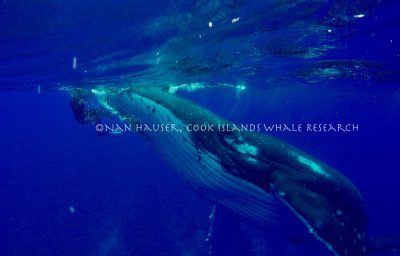 Hauser, the President and Director of the Center for Cetacean Research and Conservation, will be earning her doctorate in whale biology later this year. In Rarotonga, Cook Islands, she is the Principal Investigator for the Cook Islands Whale Research Project and Director of the Cook Islands Whale and Wildlife Center, which she is in the process of rebuilding since it was vandalized last year. Her research includes population identity, photo ID, acoustics, genetics, surface and underwater behaviour, navigation, and migration of cetaceans. Her satellite tag work includes results on how whales migrate over long distances using linear constant course segments. She has now authored more than 60 papers about her work in and around the waters of Oceania where she conducts her research. The Cook Islands are a world leader in protecting the environment and have created the world’s largest marine park, which is a staggering one million square-kilometres (four times the size of neighbouring New Zealand and eight times the size of England). For nearly 10 years, Nan was involved with the Ocean Alliance’s cetacean research expeditions aboard the R/V Odyssey. As Founder and Director of the New England Dolphin Outreach Project, she has taught on a global level for the Dolphin Research Center, Whale Conservation Institute, and many other non-profit organizations, including the Gulf of Maine Research Institute. As a Registered Nurse, she teaches and practices medicine on the outer islands of the Cooks. She is currently on the Board of Directors of the Ajubatus Foundation in South Africa and has been awarded the international title of “Earth Ambassador.”
Hauser, the President and Director of the Center for Cetacean Research and Conservation, will be earning her doctorate in whale biology later this year. In Rarotonga, Cook Islands, she is the Principal Investigator for the Cook Islands Whale Research Project and Director of the Cook Islands Whale and Wildlife Center, which she is in the process of rebuilding since it was vandalized last year. Her research includes population identity, photo ID, acoustics, genetics, surface and underwater behaviour, navigation, and migration of cetaceans. Her satellite tag work includes results on how whales migrate over long distances using linear constant course segments. She has now authored more than 60 papers about her work in and around the waters of Oceania where she conducts her research. The Cook Islands are a world leader in protecting the environment and have created the world’s largest marine park, which is a staggering one million square-kilometres (four times the size of neighbouring New Zealand and eight times the size of England). For nearly 10 years, Nan was involved with the Ocean Alliance’s cetacean research expeditions aboard the R/V Odyssey. As Founder and Director of the New England Dolphin Outreach Project, she has taught on a global level for the Dolphin Research Center, Whale Conservation Institute, and many other non-profit organizations, including the Gulf of Maine Research Institute. As a Registered Nurse, she teaches and practices medicine on the outer islands of the Cooks. She is currently on the Board of Directors of the Ajubatus Foundation in South Africa and has been awarded the international title of “Earth Ambassador.” 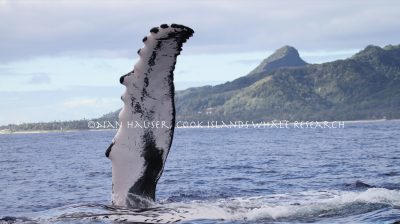 Hauser is a fierce advocate of the environment and is sought after to speak all over the world about how her research supports global warming and climate change, as well as her hypothesis that whales are great bio-indicators of what the future holds for the world. She has focused some of her research on how climate change is adversely affecting their food supply and threatens the extinction of the whales she has fought so hard to protect. In fact, she will be one of the nine featured speakers at Congreso GLACKMA, a world climate change symposium which will be held at the Laboral City of Culture Theater in Spain from February 23rd to 24th. Her friend Carlos Caraglia, who arranged for her to speak at the congress, is founder and CEO of Earth360. He was chosen as a world leader to participate in the Summit of Technological Innovation and Circular Economy and is working together with GLACKMA to film a documentary series on climate change. He is also organizing a global roadshow to publicize the reality of global warming through visual exhibitions in an impressive and unique exhibition space, our Iceberg Multimedia. Hauser has appeared on 60 Minutes and has been featured in dozens of films out about her life and work. This year alone, five new films about her work with whales are in production, as well as a feature film that will be released in Amsterdam at the end of February, co-produced with Nature Films.
Hauser is a fierce advocate of the environment and is sought after to speak all over the world about how her research supports global warming and climate change, as well as her hypothesis that whales are great bio-indicators of what the future holds for the world. She has focused some of her research on how climate change is adversely affecting their food supply and threatens the extinction of the whales she has fought so hard to protect. In fact, she will be one of the nine featured speakers at Congreso GLACKMA, a world climate change symposium which will be held at the Laboral City of Culture Theater in Spain from February 23rd to 24th. Her friend Carlos Caraglia, who arranged for her to speak at the congress, is founder and CEO of Earth360. He was chosen as a world leader to participate in the Summit of Technological Innovation and Circular Economy and is working together with GLACKMA to film a documentary series on climate change. He is also organizing a global roadshow to publicize the reality of global warming through visual exhibitions in an impressive and unique exhibition space, our Iceberg Multimedia. Hauser has appeared on 60 Minutes and has been featured in dozens of films out about her life and work. This year alone, five new films about her work with whales are in production, as well as a feature film that will be released in Amsterdam at the end of February, co-produced with Nature Films. 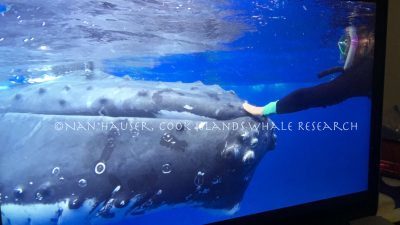 Hauser is currently working on her first book, which is scheduled to be released in the near future: My One Year Reunion With A Humpback Whale In The South Pacific, by Nan Hauser, Rarotonga, Cook Islands, South Pacific. “He’s back! I seriously never thought I would see him again…Maybe only in my wildest dreams. “We had been out on the water conducting research for a couple of hours when we got a radio call from a fisherman reporting a whale off the harbor. We found the humpback by himself and when we approached him from behind we noticed his unusual dorsal fin, which was very prominent. “The humpback dove and we waited for him to finish his nap and come up for a breath. This time he was quite far away and closer to the reef. He dove after taking 4 breaths and I took a picture of the ventral side of his tail fluke for identification purposes. I noticed that he had two deep gauges, one on each side of the top edge of his fluke. I went back to the photograph on my camera to have a closer look by zooming in on the shot. Could this possibly be my friend that protected me from the tiger shark a year and 15 days ago? Could he be back here in Rarotonga? “I grabbed my phone and went back to the underwater photographs that I had taken of him last year. He was here on September 14th, 2018 and I had only seen him that one time. It was the famous day when he had pushed me out of harm’s way from a huge tiger shark. (A few hundred million views on the internet!!) “Last year, I had spent 10 and a half minutes rolling around his body and being pushed by his head and pectoral fin as he protected me from potential danger. He kept trying to tuck me under his pectoral fin and I didn’t know why. He returned me to the boat safely and then went off chasing a female humpback passing by! That was the only time I had ever seen him. When I looked at the past and present photographs of his tail fluke, side by side, I thought that there was a good possibility that it might be him. I still wasn’t completely sure. The 'scientist' part of me had doubts.
Hauser is currently working on her first book, which is scheduled to be released in the near future: My One Year Reunion With A Humpback Whale In The South Pacific, by Nan Hauser, Rarotonga, Cook Islands, South Pacific. “He’s back! I seriously never thought I would see him again…Maybe only in my wildest dreams. “We had been out on the water conducting research for a couple of hours when we got a radio call from a fisherman reporting a whale off the harbor. We found the humpback by himself and when we approached him from behind we noticed his unusual dorsal fin, which was very prominent. “The humpback dove and we waited for him to finish his nap and come up for a breath. This time he was quite far away and closer to the reef. He dove after taking 4 breaths and I took a picture of the ventral side of his tail fluke for identification purposes. I noticed that he had two deep gauges, one on each side of the top edge of his fluke. I went back to the photograph on my camera to have a closer look by zooming in on the shot. Could this possibly be my friend that protected me from the tiger shark a year and 15 days ago? Could he be back here in Rarotonga? “I grabbed my phone and went back to the underwater photographs that I had taken of him last year. He was here on September 14th, 2018 and I had only seen him that one time. It was the famous day when he had pushed me out of harm’s way from a huge tiger shark. (A few hundred million views on the internet!!) “Last year, I had spent 10 and a half minutes rolling around his body and being pushed by his head and pectoral fin as he protected me from potential danger. He kept trying to tuck me under his pectoral fin and I didn’t know why. He returned me to the boat safely and then went off chasing a female humpback passing by! That was the only time I had ever seen him. When I looked at the past and present photographs of his tail fluke, side by side, I thought that there was a good possibility that it might be him. I still wasn’t completely sure. The 'scientist' part of me had doubts. 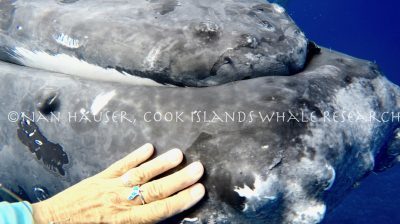 “He swam to the side of the boat a few feet away from where I was standing when he looked hard and long and carefully, directly at me. There was absolutely no doubt in my mind that he recognized me. He got closer and then I saw the white spot on his side of his head and I knew for sure that it was him! I screamed, and shouted with glee, 'Hello my friend, you’re back! I can’t believe it!' “This was especially unusual because in 21 years of whale research here in the Cook Islands, I have only had 2 humpbacks return to Rarotonga. This was the 3rd! “It was also unusual because every whale that I have Satellite Tagged in the past 2 decades in the Cook Islands had gone from East to West. I had a call that he was in Tonga 2 months ago … that means that he came from West to East. This was unbelievable! (I do love it when you have a theory and then it is disproven by a wayward whale!) “I was so excited to see him, that when he dove and was resting on the bottom just off the reef, I slid over the side of the boat practically swallowing the ocean with an enraptured grin. My research permit allows me to do this, otherwise it is against the rules and regulations to enter the water with a whale in the Cook Islands. “He was sleeping and his head was facing down towards the sea floor along the reef. The whale was in a contorted position and I took lots of pictures of him, even though the visibility wasn’t great. And THEN he woke up! My heart started pounding!
“He swam to the side of the boat a few feet away from where I was standing when he looked hard and long and carefully, directly at me. There was absolutely no doubt in my mind that he recognized me. He got closer and then I saw the white spot on his side of his head and I knew for sure that it was him! I screamed, and shouted with glee, 'Hello my friend, you’re back! I can’t believe it!' “This was especially unusual because in 21 years of whale research here in the Cook Islands, I have only had 2 humpbacks return to Rarotonga. This was the 3rd! “It was also unusual because every whale that I have Satellite Tagged in the past 2 decades in the Cook Islands had gone from East to West. I had a call that he was in Tonga 2 months ago … that means that he came from West to East. This was unbelievable! (I do love it when you have a theory and then it is disproven by a wayward whale!) “I was so excited to see him, that when he dove and was resting on the bottom just off the reef, I slid over the side of the boat practically swallowing the ocean with an enraptured grin. My research permit allows me to do this, otherwise it is against the rules and regulations to enter the water with a whale in the Cook Islands. “He was sleeping and his head was facing down towards the sea floor along the reef. The whale was in a contorted position and I took lots of pictures of him, even though the visibility wasn’t great. And THEN he woke up! My heart started pounding! 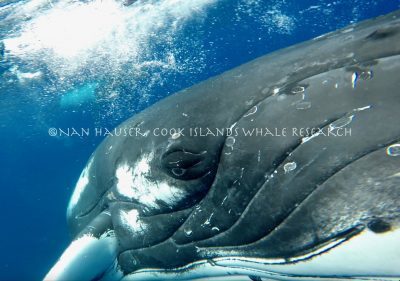 “I handed the camera to my research assistant Amy who was in the water with me. He swam up to me and had a good hard look. If whales could smile, he DID! He nudged me with his gigantic beautiful head. He kept nudging me gently and I held onto the tubercles on his face and gave him a very warm hello. “The whale then put me on the top of his head and carefully lifted me up out of the water! I felt safe and I kept wondering how I was once again graced by the presence of this incredible whale! My heart was full of such unconditional love and excitement. Instead of a warm hug from a friend, he was giving me a bit of an excited, rough slap on the back – 'Hello my friend!' Indeed, we were old friends! He was as gentle as a 50,000 pound whale can be with a 132 pound human. There was no sense of fear in his eye this time and the encounter was kind and graceful. My research team on the boat was amazed at our encounter of reuniting and took photos and video! “I hugged the whale’s pectoral fin and he lifted me out of the water while everyone else was watching with their jaws dropped! “The world thought that it was amazing that I had the opportunity to be a 'whale rider' last year, but for me it was the most terrifying thing that I have ever experienced. Now it was happening again but only as a reuniting of spirits. “I have spent 28 years underwater with whales, and this situation was so unusual that I felt like I was in a dream! The boat came towards me and I managed to swim back with my humongous whale friend escorting me!
“I handed the camera to my research assistant Amy who was in the water with me. He swam up to me and had a good hard look. If whales could smile, he DID! He nudged me with his gigantic beautiful head. He kept nudging me gently and I held onto the tubercles on his face and gave him a very warm hello. “The whale then put me on the top of his head and carefully lifted me up out of the water! I felt safe and I kept wondering how I was once again graced by the presence of this incredible whale! My heart was full of such unconditional love and excitement. Instead of a warm hug from a friend, he was giving me a bit of an excited, rough slap on the back – 'Hello my friend!' Indeed, we were old friends! He was as gentle as a 50,000 pound whale can be with a 132 pound human. There was no sense of fear in his eye this time and the encounter was kind and graceful. My research team on the boat was amazed at our encounter of reuniting and took photos and video! “I hugged the whale’s pectoral fin and he lifted me out of the water while everyone else was watching with their jaws dropped! “The world thought that it was amazing that I had the opportunity to be a 'whale rider' last year, but for me it was the most terrifying thing that I have ever experienced. Now it was happening again but only as a reuniting of spirits. “I have spent 28 years underwater with whales, and this situation was so unusual that I felt like I was in a dream! The boat came towards me and I managed to swim back with my humongous whale friend escorting me! 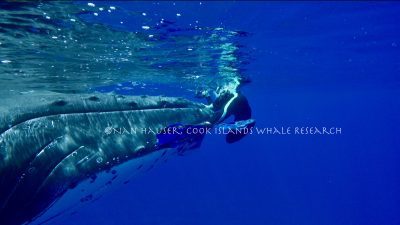 “My blubbery friend just laid under the surface of the water at the back of the boat with his head at my feet. He pressed up against the transom. “I told him the same thing that I told him last year, as I sat with my feet dangling in the water. I said, ‘I love you and thank you!’ “It’s taken me a few months to absorb this reunion. I was euphoric to be reacquainted with my old friend! My team went to shore and we sat there in awe and disbelief. We laughed and cried and had a few beers (I don’t drink, but this was one of those occasions). My dear kind protector was gone by the next morning. No one saw him again. “Once again, gone from my life, but never my memory. He had such an intense impression on me that my eyes fill with tears whenever I think of him.” Contact us to find out more Nan’s famous whale story, and be sure to check out our video archive for footage of the encounter.
“My blubbery friend just laid under the surface of the water at the back of the boat with his head at my feet. He pressed up against the transom. “I told him the same thing that I told him last year, as I sat with my feet dangling in the water. I said, ‘I love you and thank you!’ “It’s taken me a few months to absorb this reunion. I was euphoric to be reacquainted with my old friend! My team went to shore and we sat there in awe and disbelief. We laughed and cried and had a few beers (I don’t drink, but this was one of those occasions). My dear kind protector was gone by the next morning. No one saw him again. “Once again, gone from my life, but never my memory. He had such an intense impression on me that my eyes fill with tears whenever I think of him.” Contact us to find out more Nan’s famous whale story, and be sure to check out our video archive for footage of the encounter.


